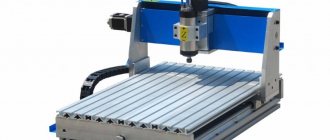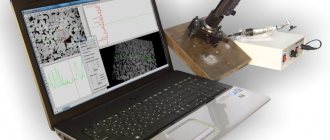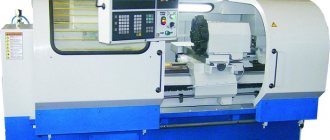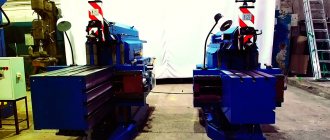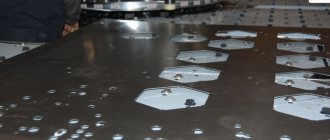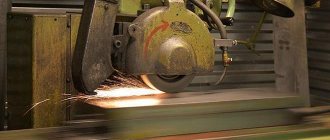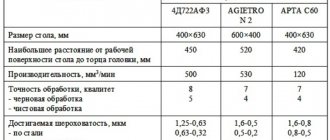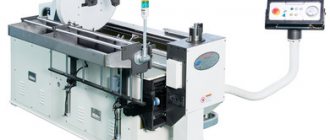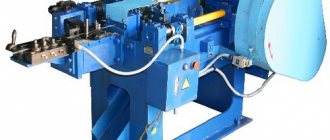Sharpening tool
For abrasive sharpening of the cutter, a sharpening machine or lathe can be used. For carbide tools, green carborundum of medium hardness is used. For initial processing, the abrasive value of the wheel should be 36-46, at the end of the process - 60-80. For high quality sharpening, a whole circle is required, without defects and geometry violations.
Diamond wheels are also widely used for sharpening turning tools, which ensures high cleanliness of cutting surfaces. In comparison with carborundum wheels, the surface cleanliness of the cutter increases by two classes, and work productivity increases. The use of diamond wheels also increases the service life of the tool - the possible number of cutter regrinds increases by 20-30%. But it should be taken into account that it is economically feasible to use sharpening with a diamond tool with an allowance of no more than 0.2 mm. For larger values, preliminary sharpening with a carborundum wheel is recommended.
Read also: How to measure amperes with a multimeter on a power supply
Order and features
Depending on the nature of wear and the design of the equipment, sharpening is carried out on the front, back or both surfaces. The figure below shows all the surfaces of a turning tool
For standard cutters, as a rule, sharpening is used on all cutting surfaces. With minor wear, only the geometry of the rear surface is restored. Equipment for multi-cutting machines is restored only on the back surface, shaped – only on the front.
Standard sharpening order:
- Main back surface.
- Auxiliary back surface.
- Front surface.
- End radius.
The back surface sharpening parameters are shown in the figure below.
Figure (a) shows the back surface with one sharpening plane, figure (b) shows several. When brazing carbide inserts, the rear surface has three planes:
- along a chamfer with a height of not less than 1.5 mm at an angle a;
- along the remaining height at an angle a+3°;
- along the holder at an angle a+5°.
Sharpening the front surface of carbide cutters has many more varieties (see figure below).
Basic forms:
- Flat with a positive rake angle (a).
- Flat with a negative angle (b).
- Curvilinear with a negative angle (c).
- Flat with negative angle for roughing (d).
- Curved with a negative angle for stainless steels (d), and other materials (e)
During the sharpening process, it is necessary that the cutting edge of the tool being processed is located on the line of the center of the sharpening machine or below by no more than 3-5 mm. The direction of rotation of the circle should ensure that the plate is pressed against the holder, i.e., it should go towards the plate. During operation, a continuous supply of coolant is desirable. With periodic cooling, overstressing of the material structure and the appearance of microcracks is possible.
When sharpening, light pressure and constant movement along the surface of the wheel are required to form a smooth surface. After sharpening is completed, the geometry of the tool is checked using templates or special instruments.
What can you use?
Sharpening can be done using two methods:
- Manual means the absence of mechanization of the entire process, that is, everything is done manually from start to finish. This method is less productive and it is quite difficult to achieve the desired result.
- There is also a device that makes sharpening chisels and wood cutters easier. Such machines also have a special stone that removes metal.
The above two processing methods are used in production. The manual method allows you to quickly sharpen the tool in case of little wear of the cutting edge and in the absence of mechanical damage. A special device allows you to restore the cutting surface and remove various defects.
Tool finishing
After sharpening, sequential grinding of the working surfaces is necessary in the same order as sharpening was carried out. When finishing, it is necessary to remove all roughness and polish the surface to a mirror shine. The cleaner the surface, the lower the friction during turning and the higher the tool life.
Finishing is carried out using boron carbide abrasive pastes on a rotating cast iron disk (no more than 2 m/s). GOI paste or other special polishing materials can be used. For polishing, paste is applied to the disc. Further, when the disk rotates, the cutter is pressed and the grains of the abrasive paste smooth out the existing roughness. Thus, the geometry and original cleanliness of the working surface of the cutter are completely restored, and its suitability for further use is ensured.
Read also: Soldering iron power for polypropylene pipes
Technological operations carried out on a lathe with workpieces using special devices are associated with ultimately obtaining a product of the desired configuration shown in the drawing. And in order for turning to be rational and accurate, sharpening of metal turning tools is necessary, which will produce the required profile, angles of the required size and the corresponding parameters of the working part. The preparation of such a tool is given great importance.
Design of turning tools
Sharpening turning tools cannot be done correctly if you do not understand the design features of such a tool. The main elements of its design are the holder rod, with which the cutter is fixed on the machine, as well as the working head: it is its cutting part that needs to be sharpened regularly.
Let's take a closer look at the working head of a turning cutter. It is formed by two types of surfaces: front and rear. The front one is very easy to distinguish: it is through it that chips are removed. The rear sides are those sides of the cutters to which the workpiece is facing during processing. They can be main or auxiliary, depending on their location.
The most important element of any cutter (including for a metal lathe) - its cutting edge - is formed at the intersection of the rear main and front surfaces. The design of any cutter also includes an auxiliary edge, formed by the intersection of its rear surfaces: the main and auxiliary. The top of the tool, which is mentioned in the specialized literature, is the intersection of its cutting and auxiliary edges.
The main characteristics of turning cutters for metal, which determine their functionality, are sharpening angles, divided into main and auxiliary. In order to determine the values of the main ones, they are measured in the plane that is formed when the cutting edge is projected onto the main plane.
In general, two planes are used to determine the angles of a cutting tool:
- the main one, superimposed on the supporting side of the turning cutter, located in its lower part (in relation to the direction of feed of the machine, such a plane is parallel);
- cutting plane located tangentially relative to the surface of the workpiece (this plane intersects with the main cutting edge of the tool).
Elements and planes of a turning tool
In the design of the working part of a turning cutter, there are several types of angles:
- points - located between the front surface of the incisor and the back main one;
- rear main ones - located between the rear main surface and the cutting plane;
- front main - located between the front side of the tool and the plane perpendicular to the cutting plane.
It is quite simple to check the correctness of their definition: their sum is always 90 degrees.
In addition to the above, the design of the working head of a turning cutter is characterized by several more angles between:
- the direction of feed and the projection that the main cutting edge makes;
- processing plane and the front surface of the cutter;
- projections that lay down the main and auxiliary cutting edges.
Purpose of the cutter, design, types
To obtain parts from a metal ingot when turning on lathe equipment, a special tool is used. They are made of steel, and the hardness of the material is higher than that of the workpiece being processed. The holder rod and the working head, the main structural elements of a metal cutter, are used to secure the tool on the lathe.
The function of the second component is to cut off a layer of the metal surface during processing. The holder rod or the body of the cutter has a square or rectangular cross-section. The main cutting edge of the working head is shaped (wedge) or straight in cross-section. Metal cutting parts require regular sharpening during operation. In modern conditions there is a sufficient choice of incisors.
Turning tools for metal processing with replaceable inserts
When choosing gear, you should take into account such an indicator as angles. The classification of species is as follows:
- checkpoints;
- cutting;
- pruning;
- boring;
- shaped;
- grooved:
- chamfered;
- persistent;
Pass-through, this type of device processes cylindrical blanks. A cutting tool is used for cutting rods. Trimming is performed at a given angle. A cutting-type device is also used to cut grooves for various purposes in them. Scoring, this type of device is used for trimming blanks and reducing ledges. Boring, this tool is used to machine holes of the required diameter in workpieces or parts on a lathe.
Grooving - the purpose of such a device is to form internal and external grooves on a cylindrical surface, maintaining the required angles. Sometimes a cutting-type function is required when it is necessary to remove part of the metal from the workpiece. Thread-cutting machines use this device to cut threads on lathes. Shaped - the purpose of this cutter is to form protrusions and grooves on the blank being processed, thereby obtaining angles with the required parameters.
Read also: How to work with a hydraulic level alone
Chamfering - with this device, after sharpening, internal and external chamfers are made on the product. The persistent one is used for turning metal parts with small ledges. To reduce vibration when working on a lathe, you need to check its position. Thrust is used for non-rigid parts.
Types of cutters are also divided according to the direction of processing of turning equipment into left and right, according to the material from which they are made, according to the method of attaching the cutting part to the holder and other parameters.
Tools for turning equipment
In order to understand the rules for sharpening cutters for metal lathes, it is not enough just to watch a training video. It is necessary to have an idea of how such instruments are classified. The most important parameter according to which turning tools are classified into different types is the type of processing performed with their help. Based on this feature, the following types of turning tools are distinguished.
The main types of turning cutters:
Through cutters,
workpieces are processed along the axis of rotation with such cutters.
Scoring
Using these cutters on a lathe, they reduce the ledges and trim the workpieces.
Grooved
As the name suggests, they form external and internal grooves on cylindrical surfaces. You can also create grooves on the outer sides of workpieces using metal cutting tools. In addition, such cutters allow you to cut parts of the workpiece at right angles.
Boring
With the help of such tools, holes are processed on machines.
Threading
These cutters are specifically designed for cutting threads.
Shaped
Using cutters of this type, shaped protrusions or grooves are formed on the outside of cylindrical workpieces.
Chamfer
With the help of these cutters, chamfers are removed from workpieces.
Operations performed with various types of cutters
Turning cutters are also divided into types depending on the direction in which they are used to process the workpiece. So, among them there are right-handed (processing is carried out towards the headstock) and left-handed (processing towards the tailstock).
Turning tools are classified according to the material of manufacture, the method of connecting the cutting part to the holder, and also according to a number of other parameters.
